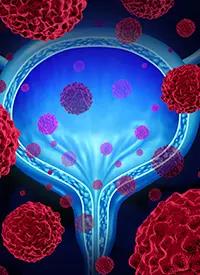News
Article
China’s NMPA Accepts sBLA for Enfortumab Vedotin Plus Pembrolizumab in Advanced Urothelial Cancer
Author(s):
China’s NMPA accepted a sBLA for enfortumab vedotin plus pembrolizumab for the first-line treatment of locally advanced or metastatic urothelial cancer.
urothelial cancer | Image Credit:
© freshidea - stock.adobe.com

The Center for Drug Evaluation (CDE) of China’s National Medical Products Administration (NMPA) has accepted a supplemental biologics license application (sBLA) seeking the approval of enfortumab vedotin-ejfv (Padcev) in combination with pembrolizumab (Keytruda) for the first-line treatment of adult patients with locally advanced or metastatic urothelial cancer.1
The sBLA is supported by data from the phase 3 EV-302/KEYNOTE-A39 trial (NCT04223856). Findings presented at the 2023 ESMO Congress showed that at a median follow-up of 17.2 months, enfortumab vedotin plus pembrolizumab (n = 442) elicited a median overall survival (OS) of 31.5 months (95% CI, 25.4-not reached) compared with 16.1 months (95% CI, 13.9-18.3) for chemotherapy (n = 444; HR, 0.47; 95% CI, 0.38-0.58; P < .00001). The 12- and 18-month OS rates were 78.2% and 69.5%, respectively, for the combination arm vs 61.4% and 44.7%, respectively, for the chemotherapy arm.2
Furthermore, patients in the enfortumab vedotin plus pembrolizumab group achieved a median progression-free survival (PFS) of 12.5 months (95% CI, 10.4-16.6) compared with 6.3 months (95% CI, 6.2-6.5) for those in the chemotherapy arm (HR, 0.45; 95% CI, 0.38-0.54; P < .00001). The 12-month PFS rates were 50.7% for the combination vs 21.6% for chemotherapy. The 18-month PFS rates were 43.9% and 11.7%, respectively.
“Locally advanced or metastatic urothelial cancer is a life-threatening condition in China with nearly half of those diagnosed succumbing to the disease. The CDE’s acceptance of our sBLA for enfortumab vedotin and pembrolizumab brings us one step closer to delivering a much-needed, innovative new treatment option for this patient population,” Ahsan Arozullah, MD, MPH, senior vice president and head of Development Therapeutic Areas at Astellas, stated in a news release.1
In December 2023, the FDA approved enfortumab vedotin in combination with pembrolizumab for the treatment of patients with locally advanced or metastatic urothelial cancer. That regulatory decision was also supported by data from EV-302.3
The phase 3 study enrolled previously untreated patients with locally advanced or metastatic urothelial carcinoma who were eligible for platinum-based chemotherapy, enfortumab vedotin, and pembrolizumab. Patients also needed to be naive to PD-1/PD-L1 inhibitors; have a glomerular filtration rate of at least 30 mL/min; and have an ECOG performance status of 0 to 2.2
Investigators randomly assigned patients in a 1:1 fashion to receive enfortumab vedotin plus pembrolizumab; or chemotherapy consisting of gemcitabine in combination with cisplatin or carboplatin for a maximum of 6 cycles. In the experimental arm, pembrolizumab was given for up to 35 cycles, and there was no limit on treatment cycles for enfortumab vedotin.
PFS per blinded independent central review (BICR) and OS served as the trial’s dual primary end points. Key secondary end points included BICR- and investigator-assessed overall response rate (ORR) per RECIST v1.1 criteria; and safety.
Additional data showed the PFS and OS benefits of enfortumab vedotin plus pembrolizumab were observed across prespecified subgroups. Notably, the OS benefit was observed irrespective of cisplatin eligibility and PD-L1 status.
Per BICR assessment, evaluable patients in the combination arm (n = 437) experienced an ORR of 67.7% (95% CI, 63.1%-72.1%), including a complete response (CR) rate of 29.1%, a partial response (PR) rate of 38.7%, a stable disease (SD) rate of 18.8%, and a progressive disease (PD) rate of 8.7%. Notably, 4.8% of patients were not evaluable for response in the experimental arm.
In the control arm (n = 441), the BICR-assessed ORR was 44.4% (95% CI, 39.7%-49.2%). The CR, PR, SD, and PD rates were 12.5%, 32.0%, 33.8%, and 13.6%, respectively; 8.2% of patients were not evaluable for response.
The median duration of response was not reached (NR; 95% CI, 20.2-NR) in the enfortumab vedotin plus pembrolizumab arm vs 7.0 months (95% CI, 6.2-10.2) in the chemotherapy arm.
Regarding safety, the rates of serious treatment-related adverse effects (TRAEs) were 27.7% for the experimental arm and 19.6% for the chemotherapy arm. TRAEs leading to death occurred at rates of 0.9% in both arms.
The rates of any-grade TRAEs were 97.0% for the combination arm vs 95.6% for the chemotherapy arm. Grade 3 or higher TRAEs occurred at rates of 55.9% and 69.5%, respectively.
Any-grade TRAEs of special interest related to enfortumab vedotin included skin reactions (66.8%), peripheral neuropathy (63.2%), sensory events (59.1%), motor events (10%), ocular disorders (21.4%), dry eye (18.6%), hyperglycemia (13.0%), and infusion-related reactions (2.0%).
Notably, the NMPA is also reviewing a BLA seeking the approval of enfortumab vedotin for the treatment of patients with locally advanced or metastatic urothelial cancer who received prior treatment with a PD-1/PD-L1 inhibitor and platinum-based chemotherapy.4
References
- China’s National Medical Products Administration accepts Astellas and Pfizer’s supplemental biologics license application for enfortumab vedotin with Keytruda (pembrolizumab) for first-line treatment of advanced bladder cancer. News release. Astellas. March 28, 2024. Accessed March 28, 2024. https://www.astellas.com/en/news/28961
- Powles TB, Perez-Valderrama B, Gupta S, et al. EV-302/KEYNOTE-A39: open-label, randomized phase III study of enfortumab vedotin in combination with pembrolizumab (EV+P) vs chemotherapy (chemo) in previously untreated locally advanced metastatic urothelial carcinoma (la/mUC). Ann Oncol. 2023;34(suppl 2):S1340. doi:10.1016/j.annonc.2023.10.106
- FDA approves enfortumab vedotin-ejfv with pembrolizumab for locally advanced or metastatic urothelial cancer. FDA. December 15, 2023. Accessed March 28, 2024. https://www.fda.gov/drugs/resources-information-approved-drugs/fda-approves-enfortumab-vedotin-ejfv-pembrolizumab-locally-advanced-or-metastatic-urothelial-cancer
- Astellas and Seagen announce China’s National Medical Products Administration accepts biologics license application for enfortumab vedotin in certain patients with locally advanced or metastatic urothelial cancer. News release. Astellas. March 10, 2023. Accessed March 28, 2024. https://www.astellas.com/en/news/27441








